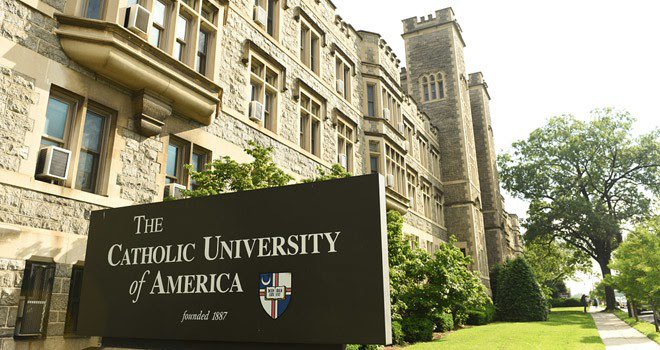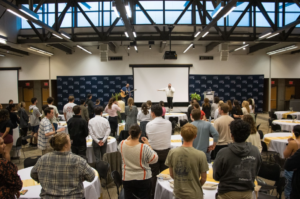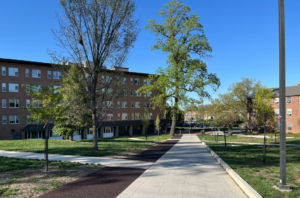CUA Faculty and Staff to Face 4% Wage Cuts

Photo Courtesy of Crisis Magazine
By Cristina Goerdt
Faculty and staff at the Catholic University of America will undergo a 4% wage cut over a period of 18 months, administration officials announced. Effective November 1 for all staff, the cuts only affect employees who earn more than $50,000 per year.
Faculty can opt to decrease their salary in November, or wait until the start of the next school year.
The announcement comes as the university faces a $35 million budget deficit following a massive drop in revenue due to the coronavirus pandemic. $20 million remains to be recovered, officials say.
According to an email sent to faculty and staff on October 8 informing them of the wage cut, the decision was made “in consultation with various stakeholders,” including various faculty committees, the Employee Benefits Council, and the Executive Committee of the Administrative Council.
In the email, university President John Garvey also announced a 5% budget cut across all departments. Depleting departmental resources “will result in eliminating some positions,” Garvey acknowledged, adding, “most of which are already vacant.”
Dr. Robin Darling Young, president of the faculty assembly, was quick to point out that the vacancy of a position does not indicate its relative importance to the success of students. Teaching opportunities with relatively high turnover rates, such as guest lecturers, adjunct professors, or non-tenure-track faculty provide valuable opportunities to diversify course offerings and allow tenured faculty to focus on research and teaching.
Speaking via Zoom, Garvey stated that protecting faculty jobs has remained one of the university’s foremost priorities since the start of the pandemic seven months ago. Other priorities include the safety of the university community, maintaining the viability of the university, and providing the best education possible under the circumstances, he said.
According to Garvey, eliminating tenured faculty positions is “off the table.” However, fears abound within the rank and file faculty. Many view the wage cuts as the latest episode in a contentious power struggle between faculty and university management.
Heated debates over influence in the decision-making process and an impressive ten years without a pay raise lie at the heart of the issue, professors explain, many of whom declined to speak on the record due to the sensitive nature of the topic.
The lack of investment in the faculty as many other aspects of the university receive significant funds creates an environment of distrust, Young said.
“Many fear that there will be another pay cut,” she said. “Many are already on edge,” too, both from the stress of the pandemic and the continued workplace tensions.
Garvey said that the 4% pay cut applicable to faculty was in lieu of a more steep reduction and that the program is designed to taper wages so that no single faculty member makes less than $50,000.
“There was a strong consensus that reductions deep enough to fill the budget gap would ask too much from our community,” he wrote in the communique to staff and faculty.
Provost Aaron Dominguez explained that the decision was made as “inclusively as possible,” with considerable “feedback” from various faculty groups and individuals.
“It was a lengthy and deliberative process,” he said.
In an interview, Garvey stressed that ensuring the future of the university required a group effort.
“This is a sacrifice everyone needs to be taking part in,” he said.
And yet, the sacrifice appears to be unequally distributed. While top-earning officials, such as Garvey himself, announced a temporary cut for their own salaries in June, it is unclear how long those reductions will take place, or what percentage of their pay was affected.
Furthermore, the university paused all contributions to faculty and staff 403(b) retirement funds at the start of the fall semester. The lack of raises — not even accounting for the cost of living increases — has placed Catholic University faculty at a distinct financial disadvantage from their peers at comparable institutions.
The university was slated to award pay increases this school year for the first time in a decade after a study conducted by consulting group Mercer concluded that faculty are underpaid by at least 8% below the market rate.
Those plans were interrupted by the financial hardships caused by the pandemic, with no clear plans to reinstate the raises or recompense the wage cut following the 18-month period.
The salary reduction in addition to the halting of retirement contributions and the loss of a long-anticipated raise has severely damaged morale among faculty members.
“It seems unproportional,” Young protested.
Vice President for Advancement Scott Rembold pushes back against the claim that the university purposefully, if malignantly, guides funds away from faculty salaries through investing in infrastructure or student life.
“A lot of the gifts we get, like those in Light the Way…those are directed,” he explained in a phone call. “That money is for specific purposes, and we can’t use it for anything else.”
Such previously pledged support allows the university to continue investment in the larger university community despite the financial hardship, permitting projects such as the new Conway School of Nursing facility to move forward on schedule. Rembold also notes, as does Garvey, that revenue is heavily dependent upon enrollment: approximately 70% of the university’s operating budget stems from tuition and associated fees.
Anonymous messages on the faculty assembly message board have pointed out that enrollment has in decline for several years. However, in the case of the 2020-21 fiscal year, it is not only the tuition itself, but also the lack of housing, dining, and other revenues that are causing stress on the university.
Such a dip in enrollment will influence later years, too, as the university moves through the next four years at least with a reduced class of 2024 and thus decreased revenue.
Addressing the issue, Garvey said that the university will consider how to provide an education to the smaller student population in the most cost-efficient manner possible, potentially re-examining faculty and staff positions.
Some faculty view their colleagues as hyperreactive, arguing that the university could not have anticipated such an event and that faculty positions are difficult to come by throughout the country, not just at Catholic University.
This attitude, though, suggests some sort of manipulation on behalf of the administration, others say, as professors perpetually kept in a position of simply being thankful for a job are less likely to complain about power-sharing or wages.
Young said that for her, the best resolution going forward would be to institute a “just and beneficial” method of shared governance and decision-making.









As an associate professor of nursing, I am excited and extremely grateful for the unparalleled generosity of the Conways. A new school of nursing is long overdue and I can’t wait for it to happen. But I worry how we are going to fill a new building with future nurses if we continue to have inadequate numbers of nursing faculty? The Mercer report revealed that nursing is the lowest paid faculty on campus. The context of a well-documented national nursing faculty shortage and an unremitting pandemic stressing healthcare professions and hospitals really compounds the problem. No matter how state-of-the-art, buildings do not teach-faculty teach. Some of us are getting very tired of an increasing workload, and salary and budget cuts every single year, both pre-pandemic and today.